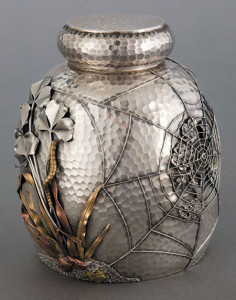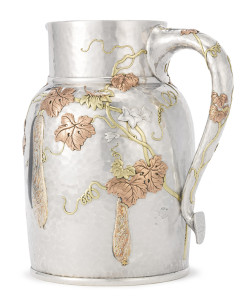Let’s say you either discover or buy an object that at first glance looks like it is Islamic, Egyptian or Japanese! All the seller or a family member knows it’s “old.” It may be made of silver or even a decorative accessory or piece of furniture. Research and history will answer the questions.
Go back to the 19th century when archeological discoveries fueled interest. The mystic of exotic far away places was everywhere. The Philadelphia Centennial Exhibition stimulated Japanese influence on American design. It was there that Charles Tiffany (father of Louis Comfort Tiffany) introduced what was dubbed “Japanesque” style silver. Neither Japanese or American, the designs startled the eyes with the use of mixed metals on silver, including ivory, on Oriental type motifs. The effect of applied decorations of gold and copper on hand-hammered silver were totally new. By 1880 Gorham manufacturing, Dominick & Haff, and Whiting Manufacturing Company were creating the Japanesque mixed metal style silver items.
The popular motifs included insects, seaweed, sea creatures and flowering trees as well as exotic birds. Tea services, trays, bowls and even ink wells were among the many such objects.
Much of the inspiration for the early Tiffany Japanesque pieces came from the private collection of Japanese art owned by Tiffany’s chief designer, Edward C. Moore. In 1877 Tiffany sent the British designer Christopher Dresser to Japan to buy artifacts of bronze, porcelain and lacquer. These were used as additional design sources. The resulting Japanesque designs were stylized versions.
 The Islamic designs introduced by Tiffany were made from a single piece of silver that was enameled, etched and gilded. The enamels followed the colors of Turkish rugs and Syrian glass mosque lamps.
The Islamic designs introduced by Tiffany were made from a single piece of silver that was enameled, etched and gilded. The enamels followed the colors of Turkish rugs and Syrian glass mosque lamps. CLUES: Japanesque pieces made by Tiffany are marked Tiffany & Co. The Islamic pieces are marked “Sterling Silver, Tiffany & Co.” or sometimes “Tiffany & Co. Makers, Sterling Silver.” Islamic influenced pieces follow the traditional shapes of Near Eastern coffee pots. Renewed interest has livened prices.
PHOTO CAPTION: (1) Japanesque silver water pitcher. Designed by Edward C. Moore for Tiffany. C.1898. PHOTO CREDIT : (1) Sotheby’s N.Y.
PHOTO CAPTION (2) Japanesque silver tea caddy. Gorham silver. PHOTO CREDIT: (2) Heritage Auctions
















Follow Us